Manufacturing and Characterization Process of Polymer Concrete with Aggregate From Pumice Stone and Corn Husk Fiber as A Filler
DOI:
https://doi.org/10.32734/jotp.v1i1.819Keywords:
Polymer Concrete, pumice, Corn Skin Fiber and Epoxy Resin, sound absorption coefficientAbstract
Research has been carried out regarding the manufacturing process of polymer concrete made from a mixture of pumice, sand (1: 1), corn husk fiber, epoxy and thinner resin. This research was conducted to determine the characterization of polymer concrete which will be tested physically and mechanically with the best composition mixture. The physical properties of polymer concrete which were analyzed namely density, porosity and water absorption; mechanical properties including impact strength, flexural strength and compressive strength, and polymer concrete microstructure analysis, namely SEM-EDX. The best results were obtained with a mixture of pumice, sand (1:1), corn husk fiber, epoxy and thinner resin. The result are as stated here, density: 1.84 g/cm3 with composition (49:49:2) 30 g epoxy resin, porosity : 0.44% with composition (50:50:0) 20 g epoxy resin, water absorption: 1.8% with composition (50:50:0) 25 g of epoxy resin. Whereas mechanical properties, on impact tests: 4.956 KJ/m2 with composition of (47:47:6) 25 g epoxy resin, flexural test: 22.22 MPa with composition of (45:45:0) 30 g epoxy resin, pressure test: 8.41 MPa with composition of (49:49:2) 30 g epoxy resin. XRD analysis shows that each of its constituents still have quartz, pumice, quartz, pumice-shaped hexagonal crystals, while corn husk fibers are amorphous crystals. The average sound absorption coefficient for the three samples (20%, 25%, and 30%) are 0.178; 0.152; and 0.234 at a frequency of 500 Hz - 6300 Hz, which meets the requirements of ISO 11654 and ASTM C.384.
Downloads
Downloads
Published
Issue
Section
License
Copyright (c) 2019 Journal of Technomaterial Physics

This work is licensed under a Creative Commons Attribution-ShareAlike 4.0 International License.











